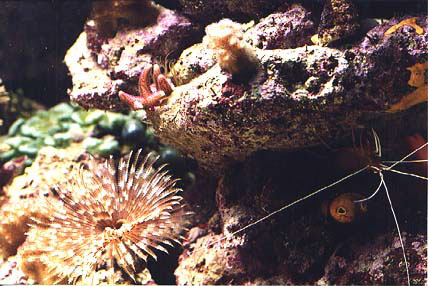

Invertebrate diversity on rocks in the
reef tank

The rock surfaces in the reef tank are literally covered with life:
- Small colonies of small-polyped stony corals are growing rapidly on
these rocks. Visible here are colonies of Pocillopora damicornis
(top center, and also behind the feather duster worm, very pale or brownish
color in this photo) and Seriatopora histrix (left center, brownish
pink color) that have grown rapidly from tiny fragments glued
to the rocks with underwater epoxy putty.
- Orange encrusting sponges are growing on the rocks at top right.
- The white antennae (right center) belong to a scarlet cleaner shrimp.
Cleaning symbioses on coral reefs: In the wild, cleaner shrimp
make their living by picking parasites and necrotic tissue off fish. The
shrimp typically rest upside down under ledges with their white antennae
sticking out to advertise their cleaning services. Fish solicit cleaning
by taking a particular posture near the shrimp that indicates the fish is
not a threat. The shrimp swim out and climb all over the fish, picking it
over for edible morsels, and even reaching into the gills or climbing into
the mouths of large fish.
A variety of other shrimp and small fish species also provide similar
cleaning services in coral reefs the world over. For example, students in
our Florida Keys Marine Biology course
in January 1998 observed cleaning being done by neon gobies, blueheaded
wrasses, juvenile porkfish, and a juvenile french angelfish. The juvenile
angelfish was cleaning a 6-foot barracuda directly beneath us as we snorkeled
at the reef! It is not uncommon at coral reefs to see groups of large fish
lined up at cleaning stations waiting to be serviced by cleaner shrimp or
cleaner fish.
- Below the shrimp is an orange tunicate (sea squirt), which is a chordate
closely related to vertebrates. Tunicates have tadpole-like larvae that
swim, but adults are sessile animals that feed on microorganisms filtered
from the water. Tunicates have two prominent openings, one for drawing
water in, one for expelling water.
- Feather duster worms (lower left) are large polychete worms that live
in leathery tubes of their own making. The large, feathery appendages emanating
from the worms' heads trap tiny food particles from the water. Tiny cilia
(small beating hairs) in grooves along the "feathers" transport
the trapped food particles to the worms' mouths. Though most people initially
think these flower-like creatures are plants, they most definitely are
animals, as is demonstrated by their sudden disappearance into their
tubes when they are disturbed!
- Out of focus in the background are growths of the green algae Dictyosphaeria
and Ventricaria. They have extremely large bubble-like cells visible
to the naked eye. In the case of Ventricaria, these cells can exceed
1' in diameter.
- The pink and purple colors on the rocks are due to growths of encrusting
coralline algae.
Back to Aquaria Image Index
![]()
![]()
